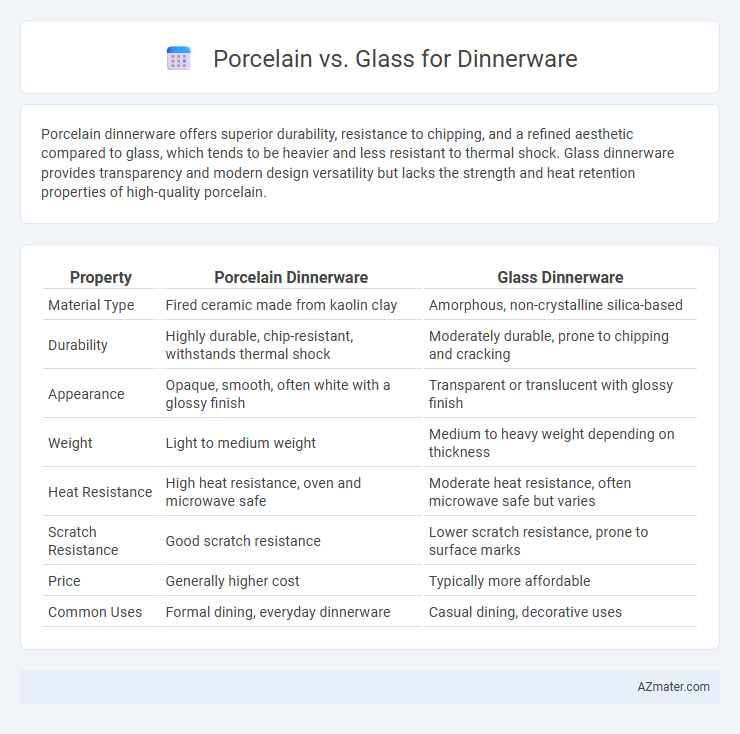Porcelain dinnerware offers superior durability, resistance to chipping, and a refined aesthetic compared to glass, which tends to be heavier and less resistant to thermal shock. Glass dinnerware provides transparency and modern design versatility but lacks the strength and heat retention properties of high-quality porcelain.
Table of Comparison
| Property | Porcelain Dinnerware | Glass Dinnerware |
|---|---|---|
| Material Type | Fired ceramic made from kaolin clay | Amorphous, non-crystalline silica-based |
| Durability | Highly durable, chip-resistant, withstands thermal shock | Moderately durable, prone to chipping and cracking |
| Appearance | Opaque, smooth, often white with a glossy finish | Transparent or translucent with glossy finish |
| Weight | Light to medium weight | Medium to heavy weight depending on thickness |
| Heat Resistance | High heat resistance, oven and microwave safe | Moderate heat resistance, often microwave safe but varies |
| Scratch Resistance | Good scratch resistance | Lower scratch resistance, prone to surface marks |
| Price | Generally higher cost | Typically more affordable |
| Common Uses | Formal dining, everyday dinnerware | Casual dining, decorative uses |
Introduction to Porcelain and Glass Dinnerware
Porcelain dinnerware, renowned for its durability, translucency, and high resistance to thermal shock, is crafted from refined clay fired at ultra-high temperatures, resulting in a non-porous, elegant surface ideal for formal dining. Glass dinnerware, made from tempered or borosilicate glass, offers versatility, dishwasher safety, and resistance to staining, with options ranging from clear to colored finishes that fit various casual and contemporary table settings. Both materials highlight unique benefits in terms of strength, aesthetics, and maintenance, influencing their suitability for everyday use or special occasions.
Material Composition and Manufacturing Processes
Porcelain dinnerware is made from a refined mixture of kaolin, feldspar, and quartz, fired at extremely high temperatures around 1,200 to 1,400 degrees Celsius to achieve a dense, non-porous, and durable structure. Glass dinnerware, typically crafted from soda-lime or borosilicate glass, undergoes processes such as melting, molding, and annealing to create sturdy, transparent or translucent pieces, with borosilicate providing enhanced thermal resistance. The vitrification process in porcelain manufacturing results in a strong, chip-resistant surface, while glass dinnerware emphasizes clarity and thermal shock resistance depending on its specific composition.
Aesthetic Appeal: Visual Differences
Porcelain dinnerware features a smooth, translucent surface with a delicate, glossy finish that enhances its refined and elegant aesthetic appeal, making it ideal for formal settings. Glass dinnerware offers a clear or tinted, often reflective and modern look, providing versatility in style but generally lacking the depth and warmth of porcelain's texture. The visual differences highlight porcelain's classic sophistication versus glass's contemporary minimalism.
Durability and Strength Comparison
Porcelain dinnerware is highly durable due to its dense, vitrified structure, making it resistant to chipping and cracking under regular use. Glass dinnerware, particularly tempered glass, offers good strength but is generally more prone to breakage from impact or sudden temperature changes. Porcelain's superior resistance to wear and structural integrity ensures longer-lasting performance compared to most glass options.
Weight and Handling Comfort
Porcelain dinnerware is typically lighter and thinner than glass, offering greater ease of handling and a more comfortable grip during meals. The smooth, often slightly translucent surface of porcelain reduces hand fatigue, making it preferable for prolonged use. Glass dinnerware, while generally heavier and more rigid, can feel sturdier but may cause discomfort with extended handling due to its weight and lack of ergonomic design.
Suitability for Everyday vs. Special Occasions
Porcelain dinnerware offers exceptional durability and resistance to chipping, making it ideal for everyday use while maintaining an elegant appearance suitable for special occasions. Glass dinnerware, often more fragile and prone to breakage, is typically reserved for formal settings or occasional use due to its delicate nature. The choice between porcelain and glass depends on balancing everyday practicality with the desired aesthetic for celebratory meals.
Heat Resistance and Microwave Safety
Porcelain dinnerware offers superior heat resistance, withstanding temperatures up to 1200degF, making it safe for use in ovens and microwaves without cracking or warping. Glass dinnerware varies, with tempered glass handling microwave use well but some types, like soda-lime glass, prone to thermal shock and breakage under high heat. Choosing porcelain ensures reliable microwave safety and durability, while glass requires verification of heat resistance before use in high-temperature settings.
Maintenance: Cleaning and Stain Resistance
Porcelain dinnerware offers superior stain resistance and can be easily cleaned with mild detergents without absorbing odors or colors, making it ideal for long-term maintenance. Glass dinnerware is generally dishwasher safe but may show water spots and scratches more visibly, requiring frequent polishing to maintain its clarity. Porcelain's non-porous surface ensures less buildup and easier removal of food residues compared to the more delicate surface of glass.
Sustainability and Environmental Impact
Porcelain dinnerware offers superior durability and longevity, reducing the frequency of replacements and waste compared to glass, which is more prone to chipping and breakage. Porcelain production typically requires higher firing temperatures but uses natural materials like kaolin clay, resulting in lower environmental toxins than the silica and soda-lime glass used in glassware manufacturing. Both materials are recyclable; however, porcelain's longer lifespan and resistance to wear contribute to a smaller overall carbon footprint and less landfill accumulation over time.
Price Range and Value for Money
Porcelain dinnerware generally commands a higher price range due to its durability, fine craftsmanship, and elegant appearance, making it a long-term investment for households seeking longevity and sophistication. Glass dinnerware offers a more affordable option, prized for its versatility and ease of maintenance but may lack the strength and refined aesthetic of porcelain. Evaluating value for money hinges on usage frequency, with porcelain excelling in durability and timeless appeal, while glass suits budget-conscious consumers prioritizing immediate cost savings.

Infographic: Porcelain vs Glass for Dinnerware
 azmater.com
azmater.com